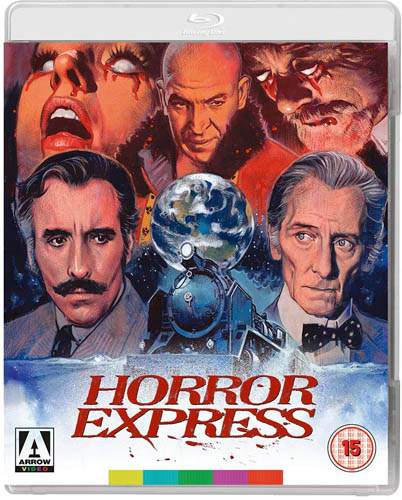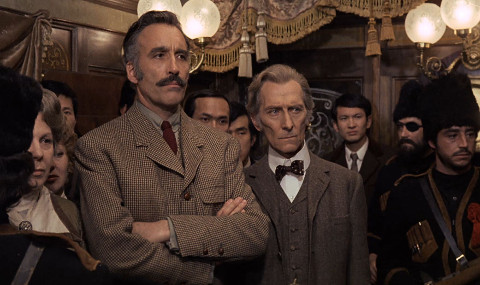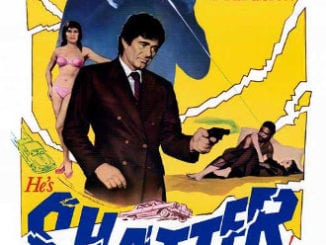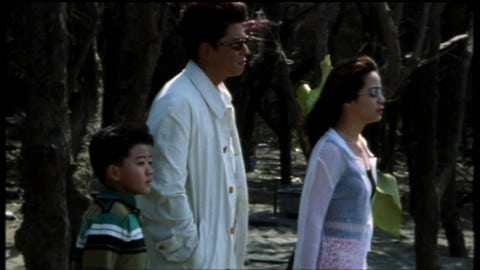Horror Express (1972)
Directed by: Eugenio Martín
Written by: Arnaud d'Usseau, David Gordon, Julian Zimet
Starring: Alberto de Mendoza, Christopher Lee, Peter Cushing, Telly Savalas
Spain
AVAILABLE ON BLU-RAY: 11th February, from ARROW VIDEO
RUNNING TIME: 84 mins
REVIEWED BY: Dr Lenera, Official HCF Critic
In 1906, renowned anthropologist Alexander Saxton finds the frozen remains of a creature half man and half ape in Manchuria. Convinced it’s the missing link, he decides to take it back to England in a crate, but as he’s about to get on the train from Peking to Moscow, Catholic monk Father Pujardov claims that the crate is evil, and a thief looks into the crate and dies with bleeding eyes. Also on the train is Saxton’s friendly rival Dr Wells. Saxton’s eagerness to keep his find a secret arouses the suspicion of Wells, who bribes a porter to investigate the crate. The porter is killed by the defrosted humanoid within, which then escapes….
”What if one of you is the monster?” asks one character in Horror Express to our two heroes, played by the immortal Peter Cushing and Christopher Lee. “Monsters?”, cries an aghast Cushing, “we’re British you know”. That probably sums up this often daft but imaginative and highly entertaining sci-fi/horror effort, which does its very best to stretch a meagre budget and for the most part succeeds. It was clearly inspired by John W. Campbell Jnr’s novella Who Goes There [with the odd influence from Quatermass And The Pit and Shanghai Express], filmed of course in 1951 as The Thing From Another World and then in 1982 [slightly more faithfully] as The Thing. For much of the time it’s carried along by an attitude that’s sometimes on the edge of being tongue in cheek, and is sometimes definitely tongue-in-cheek in some of its dialogue, yet stops short of becoming a spoof and does attempt some genuine scares and suspense too, while with one notable exception the cast treat it deadly seriously [which for some may just make things funnier of course]. And, while they may have made several better films, it remains one of the definitive Cushing/Lee pairings because they’re on screen together throughout unlike in most of their pictures where they’re usually adversaries and therefore don’t meet very often. Here, they’re both good guys, their chemistry together pouring off the screen so you get a sense of their great friendship. What’s especially interesting here is that they seem to be partly playing themselves – Cushing’s character is even mildly lecherous, it being well known that Cushing certainly had an eye for the ladies [though what man wouldn’t when surrounded by all that Hammer Glamour?] even though he probably never cheated on his wife.
Originally entitled Panic On The Train To Siberia and retaining that title for its native Spanish release, it was the second of three collaboration between Spanish director Eugenio Martin and American screenwriter/producer Bernard Gordon who had been blacklisted during the McCarthy witch hunts and therefore had to work abroad. The project began because they had this two carriage set that they’d built and used for Pancho Villa [it was claimed for many years that it was the same one that had been used in either Doctor Zhivago or Nicholas and Alexandra but in 2000 Gordon refuted this,] and wanted to make use of it. Gordon’s story treatment was expanded into a screenplay by Arnaud d’Asseau and Julian Halevy. Shot in Madrid with a largely Spanish cast and crew, they would film in one carriage, then in the next one while the set in the first one was being modified to look like another carriage, and so forth. When Cushing first arrived at the airport, he told Gordon that he could no longer do the film due to being distraught over the recent death of his wife Helen, but Lee changed his mind by reminding him of some of their previous collaborations and how much fun they had. However, Cushing suffered from night panic, so Lee would often sleep in Cushing’s bed so he wouldn’t be alone when the attacks happened. Horror Express flopped in its native country though was a moderate success abroad and was surprisingly well reviewed, though it didn’t hit the UK till 1974. US prints were awful, possibly taken from a work print for unknown reasons, and, while frequent TV showings gave the film it a cult following, it soon fell into the public domain meaning that video and then DVD copies also tended to be very poor for many years, with some prints even replacing the opening shot of the train with a blank screen.
Saxton narrates some opening words over a shot of explorers in the desert that looks like it could have been taken from a documentary, as the texture seems different and the cut to some model mountains jars a little. The discovery of the ape-man in a cave takes up just a few seconds of screen time, and I do wonder if it needed to be shown at all, instead the film beginning at Peking’s train station. “Well look who’s here”? says Lee’s Saxton to Cushing’s Wells rather joyfully the moment he sees him, encapsulating both the warmth between the two stars in four words and the sense of the film being a bit of a lark. The script immediately shows itself to be very adroit at showing us characterisation quickly through action. Wells offers an official money to get certain information, while Saxton resorts to violently knocking everything off the official’s table to get the same information! Also boarding the train are Father Pujardov who thinks that evil is inside Saxton’s mysterious crate – well something’s clearly wrong when a guy who opened it is found dead with his eyes turned white and bleeding, and when Pujardov’s chalk fails to make the marking of the cross on the side of the crate. Pujardov is clearly meant to evoke Rasputin considering his looks. Then there’s Count Maryan Petrovski and his wife Irina, Inspector Mirov, and Natasha, a glamorous lady who immediately ingratiates herself with both Saxton and Wells who find themselves even sharing the same cabin but are understandably happy to make room for this third person. “I can make it worth your while” she says to them both which conjures up the most amusing scenario that Cushing and Lee could have been in. She makes out that she’s in trouble, but there’s clearly something ‘off’ about her.
Meanwhile the creature inside the crate has thawed out and after killing a porter is able to get out by picking the lock. Sounds stupid, but it soon becomes apparent in an autopsy that the monster is draining victims of all knowledge and memory through their eyes, so is therefore learning more and more. It’s soon shot dead, but that’s not the end of it, because the alien presence inside it can take over other people, though especially one particular person who’s somehow able to hide his monstrous arm from everybody in sight. But then there’s also a scene of incredible absurdity which even seeing this film for the first time as a younger teenager I thought to be one of the silliest scenes I’d seen in a while. Saxton and Wells deduce that the monster has been absorbing memories through his eyes, so they remove one of the eyes and cut a little piece off it. Looking at the piece through a microscope, they see photographs of some of his victims, then two textbook illustrations of dinosaurs [?] and finally a shot of the earth from space [?], supposedly proving that the thing is an alien who landed on earth million of years ago. I can imagine Lee and Cushing pissing themselves while performing the scene and it may even have made Cushing forget about his dear Helen for a couple of minutes. No wonder that the mad monk seems to switch from the side of good to evil as soon as he’s taken a look at this. But then you’re not really supposed to take the film too seriously anyway, and then, just when things are threatening to run out of steam [sorry], an inebriated-looking Telly Savalas shows up with some armed men as a Cossack to attempt to chew every single bit of scenery in sight [for some reason I always crack up when he takes somebody’s glasses off to speak to them, then puts them back on him when he’s finished], and then we even get some zombies, white eyed like the ones in The Earth Died Screaming and looking very menacing indeed.
Suggestions that we’re dealing with either Satan or an alien force contradict each other, but there’s a good moment when it offers to help Saxton cure disease and end hunger. You feel like it might mean this, but Saxton decides that it cannot be left alive. And somebody talking of space travel in 1906 is actually plausible because the character is referring to Konstantin Tsiolkowsky, the so-called ‘father of rocketry’, who was publishing scenarios for space-travel around the time. The horror stuff is still quite effective. Bleeding eyes are always a powerful and somewhat symbolic image in horror films. i.e.Taste The Blood Of Dracula and City Of The Living Dead, and they’re used well here, while Martin solves the problem of not having the money to show the ‘draining’ properly by utilising out of focus shots, dissolves and jump cuts. It’s crudely effective, though there are maybe a few too many of these moments. There’s a bit of medical gore that must really have made the Cushing, who played Frankenstein several times, feel quite at home, though aside from some whipping there’s practically no onscreen violence until the climax where Martino uses quite effective quick, disjointed cutting to try to convey what he had neither the budget nor space to show properly – though there is the odd moment which suffers from being cramped, like when somebody’s trying to break into the crate with an axe and is nowhere near swinging it back enough to do any damage! But the ape-man suit is decent with a really creepy face which isn’t lingered upon and is often just seen partly as the creature is able to wonder around the train unseen – yet still provides some tense moments like when it’s in a cabin with two sleeping children. Meanwhile the interior train sets do convince and we do believe that we are at a busy train station at the beginning for a few minutes or so. The model train tends to look good from low angles and not so good from high ones, though the use of an actual sky rather than a back projected one helps so the shots still tend to look rather better than was the norm.
There really must have been a lot of temptation for Cushing and Lee to condescend to the material, but like the total professionals they were, they refuse to do so. Of course Cushing looks very gaunt and visibly shaken as he did in all the films he made soon after Helen’s death – and he made a great many, wisely deciding that keeping busy was the best thing to do. One thing that I’ve never been quite sold on unlike many of the film’s fans is the music score by John Cacavas. It has a catchy whistling theme and an interesting sound with use of some unusual instruments, but to me it often seems to be too jaunty for the film and doesn’t seem to be matching what’s taking place on screen very much. It also does have one very strange moment when Irina is playing the main theme on the piano and when she stops somebody seems to be whistling the same music without any instrumental backing and she asks “I wonder who that is”? Maybe it’s the monster? But then trying to find answers to things in Horror Express is probably a fool’s errand. Though it probably shouldn’t hang together at all, the film somehow just really works, with most involved clearly trying to do the very best with the material for very little money, and really enjoying themselves while they do so. The train setting, slight chills, creepy imagery, crazy plotting, cracking dialogue and two of the greatest horror icons sharing scene after scene makes for an old school sci-fi/horror treat that you may not consider to be a classic – but which you’ll probably go on to watch far more often than many of the films that are.
Rating: 









I didn’t obtain Severin’s 2015 Region ‘A’ Blu-ray of the film, which was probably the first time Horror Express had looked any good on a home viewing release, though it was seemingly flawed by having a poor encode. Arrow’s release certainly doesn’t have that problem and is immensely superior to the DVD I have which had an especially shoddy looking beginning. The brown dominated look of the film certainly didn’t help matters, and even with Arrow’s restoration the film isn’t the most appealing looking watch, but at last I was able to notice clear detail which had formerly been obscured yet with the black levels nice and deep and showing cinematographer Alejandro Ulloa’s work to be very good indeed in this area. Like the giallos I’ve recently been reviewing, the film was shot silently with the three main stars post-dubbing their own parts and everybody else being dubbed by others. They all seem to be mouthing English and actually the dub is one of the better sounding ones I’ve heard from the period, quite well recorded so it doesn’t sound tinny. The film comes with the option of watching it proceeded by a very enthusiastic introduction, taken from the Severin release, by Fangoria editor Chris Alexander who talks of his first time watching the film and why he likes it so much. Even if you’ve never seen the film before, I recommend you do watch it as it will really get you ramped up!
Arrow have ported over all the Severin special features except for a Cushing interview which I’d have liked to have heard, but as compensation they’ve provided three new extras, two of which aren’t mentioned in publicity so must have been produced at the last minute. Oddly the audio commentary is listed last on the menu, so first up is Ticket To Die, where Steve Huberman puts the film in its place in the genre, praises the direction and goes into the terrible US distribution. A bit short, but good. Night Train To Nowhere discusses the writer/producer who had an interesting career which often saw him write loads of scripts for which he wasn’t credited for due to being blacklisted. We hear how he was ‘named’ by producer William Alland who was supposedly his friend, plus a more detailed version of how Lee got Cushing to do the film. Now we get the three Severin featurettes, beginning with Murder On The Trans-Siberian Express where Martin apologises for his bad English even though it’s actually fine, before discussing the film and in particular what Cushing and Lee were like on the set. Notes From The Blacklist is an interview with Gordon that was done in 2005 but never released. While it doesn’t mention Horror Express much, I personally found it fascinating as I’ve always been intrigued by the McCarthy blacklistings [basically he thought Hollywood was full of dangerous communists] but he also explains it in an easy to understand fashion if you don’t know about it. He also relates some great stories while working on Samuel Bronston’s epics like one of my all-time favourites in that genre El Cid – I had no idea that Sophia Loren got him to write four love scenes for her and Charlton Heston after the script was supposedly completed. And Telly And Me has Cacavas discuss his career which really took off when he went to work in TV, in particular working with and his long friendship with Savalas, who even sung on some albums for which he wrote the music.
Though sometimes brief and repeating information, these featurettes are all worthwhile – though to be honest it was the audio commentary I was most looking forward to, and I was glad that it was the last thing I came to. Stephen Jones and Kim Newman have provided some excellent talk tracks over the years, and they don’t disappoint here, giving us their usual lively and informative [trivia: who was in both Horror Express and the original Murder On The Orient Express?] offering. They play off each other so well, and are among the few doing these things who don’t feel the need to state exhaustive biographies when mentioning cast and crew members. I’d be happy for them to do commentaries on virtually any movie if they didn’t hate it.
Horror Express sets out to just give the viewer a real fun ride and it seems that most involved with it clearly got into the spirit and tried to do their very best with the limited means at their disposal. A minor cult classic which looks really good for the first time and with some complimentary special features – Highly Recommended.
SPECIAL EDITION CONTENTS
*Brand new 2K restoration from original film elements
*High Definition Blu-ray (1080p) presentation
*Original Uncompressed mono audio
*Optional English subtitles for the deaf and hard of hearing
*Introduction to the film by film journalist and Horror Express super-fan Chris Alexander [6 mins]
*Ticket To Die: A look at the film by writer Steven Huberman [8 mins]
*Night Train To Nowhere: Ted Newson on Bernard Gordon [15 mins]
*Murder on the Trans-Siberian Express – an interview with director Eugenio Martin [13 mins]
*Notes from the Blacklist – Horror Express producer Bernard Gordon on working in Hollywood during the McCarthy Era [30 mins]
*Telly and Me – an interview with composer John Cacavas [8 mins]
*Brand new audio commentary with Stephen Jones and Kim Newman
*Original Theatrical Trailer
*Reversible sleeve featuring newly commissioned artwork by Graham Humphreys
*FIRST PRESSING ONLY: Fully-illustrated collector’s booklet with new writing by Adam Scovell








Be the first to comment